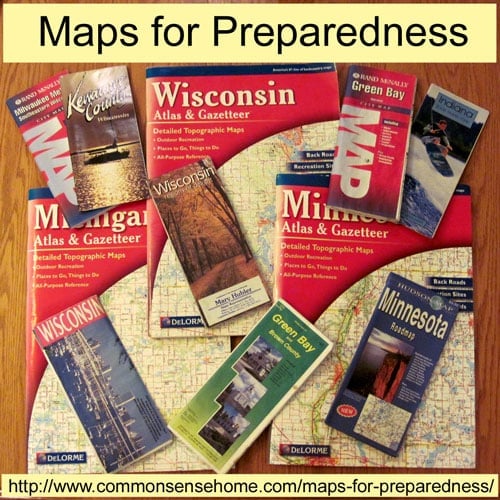Maps for Preparedness
This post may contain affiliate links. Read my full disclosure here.
Hard copy maps for preparedness are an item that many people may not even consider that could save your life.
If you need to evacuate, you can plot alternate routes to avoid congestion and problem areas. If you need to hunker down in place, you can mark local resources and friends and neighbors, as well as high risk areas.
This post outlines map suggestions that can help keep your family safe and stocked in case of emergency, and provided for as you build your food and preparedness stores.
We recommend hard copy maps because the power is often out during emergencies and certain emergencies such as solar flares or EMP pulses will disrupt electronic equipment.

Table of contents
Preparedness Maps in the Country
Piece together nine of the USGS 15-minute maps, with your camp, house or property on the center map.
Mount that map on an oversize map board (or large sheet of cardboard). Draw in the property lines and owner names of all of your surrounding neighbor’s parcels in at least a five mile radius.
Get boundary line and current owner name info from your County Recorder’s office. Many times that information can be found online. Study and memorize both the terrain and the neighbors’ names.
Cover the whole map sheet with a sheet of heavy-duty acetate or thin paper, so you can mark it up just like a military map. It will help you get to know your neighbors. When you are introduced to one of them, you will be able to say, “Oh, don’t you live about two miles up the road between the Jones place and the Smith’s ranch?”
Make up an emergency contact list with phone numbers/e-mails that corresponds to all of the names marked on the map, plus city and county office contact numbers for quick reference. Tack the list upright next to the map board, and keep an extra copy in your emergency information binder.
As you get to know people, you can make notes on the phone list or the map about resources they may have for barter or sale.
Since we’ve moved here, I’ve found neighbors who are willing to share, trade or sell: eggs, milk, beef, walnuts, rhubarb, asparagus, homemade soap and more. See The Art of Barter: How to Trade for Almost Anything for more information on bartering.
Preparedness Maps in the City and Suburbs
Mapping every single neighbor in a give mile radius is not going to work very well in a more crowded environment, but it is good to at least know those who live closest to you and to have their contact information.
Would you like to save this?
Remember the concept of “safety in numbers”. If things get crazy, it’s a heck of lot better to be surrounded by people who have your back and who may be likely to work with you to cope with whatever unfolds.
Emergency contact information for your municipality should also be kept with the neighborhood emergency contact list.
Many municipalities now offer emergency notification services via phone or text message to let you know when a dangerous situation arises in your area. Make sure to confirm that you are on this contact list if it is available. (This goes for the country, too.)
Know your exit routes, map them. Have multiple exit routes, don’t plan on just one. If there is an emergency, primary routes are likely to be blocked by traffic.
Depending on the type of emergency, traffic may also be rerouted around certain areas (in the case of accidents such as crashes or chemical spills, for instance.)
Map to multiple exit point, or alternate stash points such as a storage unit. Have several routes to family members/team members.
See Bug Out Bag or Get Home Bag for some ideas on what to pack when you need to scoot in a hurry.
Know Your High Risk Areas
City or country, you know there are areas that *may* be more likely to be problem spots. These include, but are not limited to:
- Rivers and other waterways, flood zones
- Fault zones or areas prone to sink holes
- Chemical plants or power plants
- Heavy traffic areas, especially those that are prone to fog, ice, or heavy rain
- High value targets for terrorists, such as large public venues or government buildings
- Tornado or hurricane prone areas
A reader noted that during a period of excess rain, they put red dots on their map to mark high water points where the roads were blocked. This is a great idea because local knowledge is always best.
As always, evaluate your risks, and plan your preparedness mapping accordingly.
Related Articles

This post was written by August Neverman IV. August has a strong background in emergency preparedness. He served on several emergency preparedness teams during his tenure at Brown County WI Government, the Medical College of Wisconsin, HSHS, a 13-hospital system and emergency response training during his time with the Air Force and Air National Guard. Learn more about August.

Thank you so very much.
Just want you to know I love your site! It is one stop shopping for all things homestead! My husband and I are headed in that direction, our goal is to move onto a piece of property somewhere 2 years from now. We hope to buy it this summer so we have 2 years to develop and build.
I am sure I will be making many more visits to your site in the months and years to come!
Thanks again.
Julie
Hi Julie! I like your blog name. 🙂 Much success to you and your family with your homesteading adventures, and thank you for your kind words.
This is actually on our Preplist this weekend – get a local map and a state map for each of our go bags and for the cars. We’ve done a printed city map that we’ve covered in contact paper to keep it more waterproof and rolled to be able to have ways of getting through the countryside immediately.
Good for you! We’ve got an assortment of maps, but are still building the collection. Another interesting thing that I didn’t mention in the post is zoning for different areas. Our township has a long term development plan and is zoned accordingly, so this helps keep track of what’s likely to be built in an area.
I love maps and we’ve amassed quite a collection! Thank you so much for hosting! If you’ve ever wanted to own your own grain mill I wanted to let you know I’m doing a giveaway on my blog! On The Home Front
Sounds like a great giveaway.